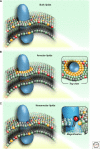Specificity of intramembrane protein-lipid interactions
- PMID: 21536707
- PMCID: PMC3098675
- DOI: 10.1101/cshperspect.a004705
Specificity of intramembrane protein-lipid interactions
Abstract
Our concept of biological membranes has markedly changed, from the fluid mosaic model to the current model that lipids and proteins have the ability to separate into microdomains, differing in their protein and lipid compositions. Since the breakthrough in crystallizing membrane proteins, the most powerful method to define lipid-binding sites on proteins has been X-ray and electron crystallography. More recently, chemical biology approaches have been developed to analyze protein-lipid interactions. Such methods have the advantage of providing highly specific cellular probes. With the advent of novel tools to study functions of individual lipid species in membranes together with structural analysis and simulations at the atomistic resolution, a growing number of specific protein-lipid complexes are defined and their functions explored. In the present article, we discuss the various modes of intramembrane protein-lipid interactions in cellular membranes, including examples for both annular and nonannular bound lipids. Furthermore, we will discuss possible functional roles of such specific protein-lipid interactions as well as roles of lipids as chaperones in protein folding and transport.
Figures


References
-
- Anderson RG, Jacobson K 2002. A role for lipid shells in targeting proteins to caveolae, rafts, and other lipid domains. Science 296: 1821–1825 - PubMed
-
- Belrhali H, Nollert P, Royant A, Menzel C, Rosenbusch JP, Landau EM, Pebay-Peyroula E 1999. Protein, lipid and water organization in bacteriorhodopsin crystals: A molecular view of the purple membrane at 1.9 Å resolution. Structure 7: 909–917 - PubMed
-
- Bertero MG, Rothery RA, Palak M, Hou C, Lim D, Blasco F, Weiner JH, Strynadka NC 2003. Insights into the respiratory electron transfer pathway from the structure of nitrate reductase A. Nat Struct Biol 10: 681–687 - PubMed
Publication types
MeSH terms
Substances
LinkOut - more resources
Full Text Sources
